Effective Strategies for Handling Stains and Spills on Upholstered Furniture (Guide)
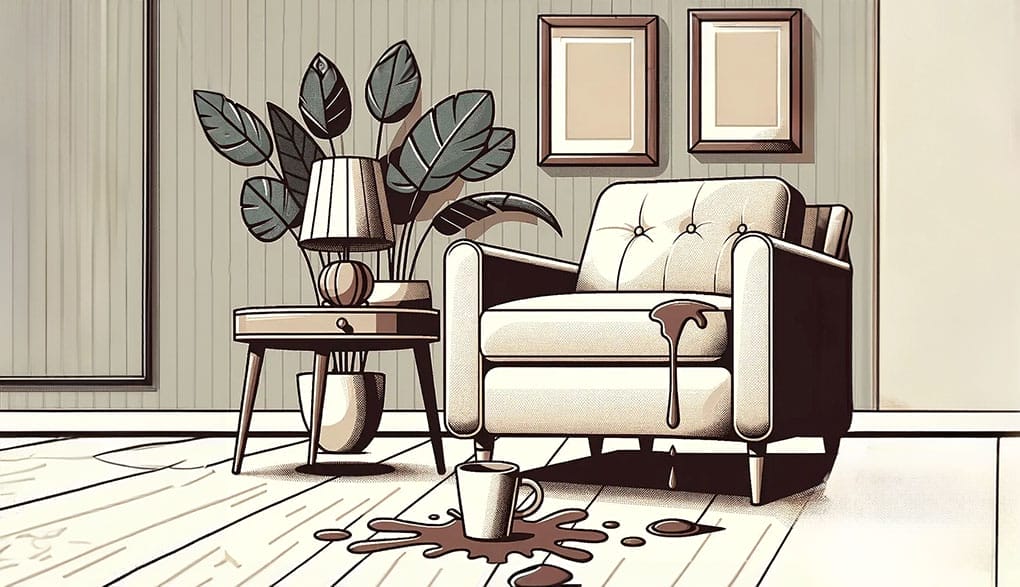
Spilled coffee on your favorite chair? Don’t panic! This guide covers effective solutions for various upholstery stains.
Before you panic, here’s an overview to tackle those pesky stains. Whether it’s an accidental wine spill or a surprise from your furry friend, let’s dive in and turn those mishaps into a thing of the past.
| Stain Type | Solution |
|---|---|
| Food 🥘 and Beverage Stains ☕ | Blotting and Using Mild Detergents |
| Ink Stains ✒️ | Blotting and Alcohol-Based Solutions |
| Grease and Oil Stains 🛢️ | Absorbing Excess Oil and Detergent-Based Cleaning |
| Red Wine Stains 🍷 | Salt and Club Soda and Wine Stain Remover |
| Chocolate Stains 🍫 | Detergent Solution |
| Blood Stains 🩸 | Cold Water Rinse and Hydrogen Peroxide |
| Pet Stains 🐶 | Blotting and Removing Solid Residue and Using Enzyme Based Cleaners |
In this article, I’ll walk you through some of the best ways I’ve discovered to tackle these unexpected messes head-on. I’ve covered you, from spot cleaning to using upholstery cleaners and even a few trusty home remedies.
The Challenge of Stains and Spills on Upholstered Furniture
Upholstery fabrics are typically porous, meaning they absorb liquids quickly. It seeps deep inside the fibers, where it can cause lasting damage. Certain spills – like those from acidic substances – can weaken the fibers over time.
It’s not just about looks; dealing with upholstery stains is about understanding what you’re up against and knowing the right way to handle it.
Steps for Managing Stains on Upholstery
When that spill happens, it’s go-time! Your quick action can differentiate between an easy fix and a permanent blemish.
Step 1: Know Your Fabric
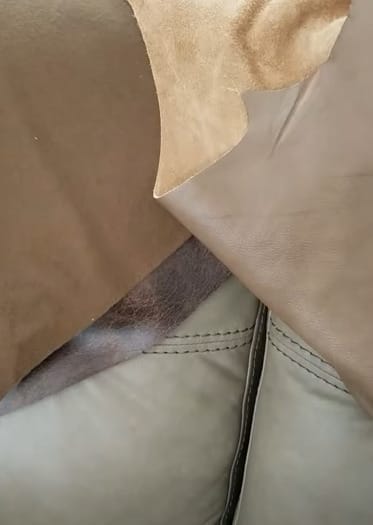
- Before diving into stain removal, it’s essential to understand your upholstery’s fabric type. Different fabrics have unique reactions to cleaning methods:
- Natural Fabrics: Such as cotton, linen, wool, and silk. They’re typically more delicate and may be prone to fading with aggressive cleaning.
- Synthetic Fabrics: Like polyester, nylon, acrylic, and olefin. These are generally more resistant to stains and can handle stronger cleaning solutions.
Step 2: Check the Upholstery Cleaning Codes

- Always check your furniture’s cleaning codes before starting any cleaning process. You’ll typically find these labels under cushions or on the bottom of the piece. Here’s what they mean:
- ‘W’: Only use water-based cleaners.
- ‘S’: Only use solvent-based cleaners.
- ‘WS’ or ‘SW’: Both cleaners are safe.
- ‘X’: Only vacuum or brush — don’t use any cleaner.
Step 3: Blot Instead of Rubbing
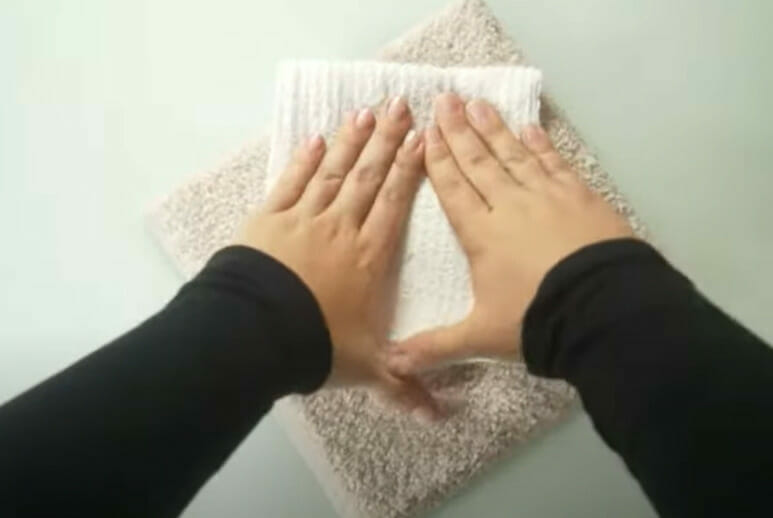
- Blotting is always better than rubbing when it comes to spills. Blotting gently lifts the liquid up into your cloth or paper towel, whereas rubbing can grind the stain deeper into fabric fibers.
- This isn’t just my opinion—it’s backed by professionals in upholstery cleaning who deal with stains daily.
Step 4: Identifying the Stain Type
- Next up, you’ve got to figure out what you’re dealing with. The type of stain dictates how you should tackle it:
- Oil-based stains: Came from things like butter, cooking oil, or makeup. They require a dry-cleaning solvent.
- Protein-based stains: Think blood, sweat, milk—anything body-related! A mixture of water and enzyme detergent works best here.
- Tannin or dye-based stains: Red wine falls into this category (it’s not your friend!). You’ll need a mix of dish soap and hydrogen peroxide for these bad boys.
Step 5: Testing a Hidden Area
- Before going full steam ahead with any cleaning solution, though, let’s do some sneaky recon work on an inconspicuous area of your furniture first.
- Certain cleaners may alter color or texture while removing that stubborn stain.
Common Stains and Solutions
I’ve had my fair share of upholstery battles. Here’s my playbook:
Food and Beverage Stains
Ah, food and drink spills! Who hasn’t experienced the horror of seeing their favorite couch bear the brunt of an accidental coffee spill or a stray pasta sauce splash?
Step 1: Blotting and Cleaning Methods
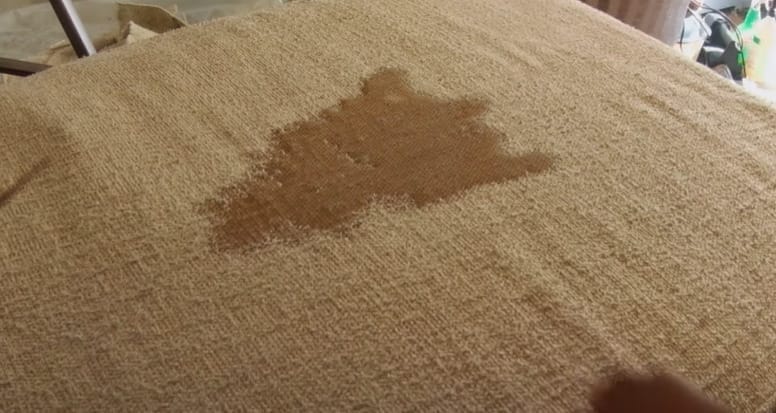
- Start by blotting up as much of the spill as possible using paper towels or clean cloths.
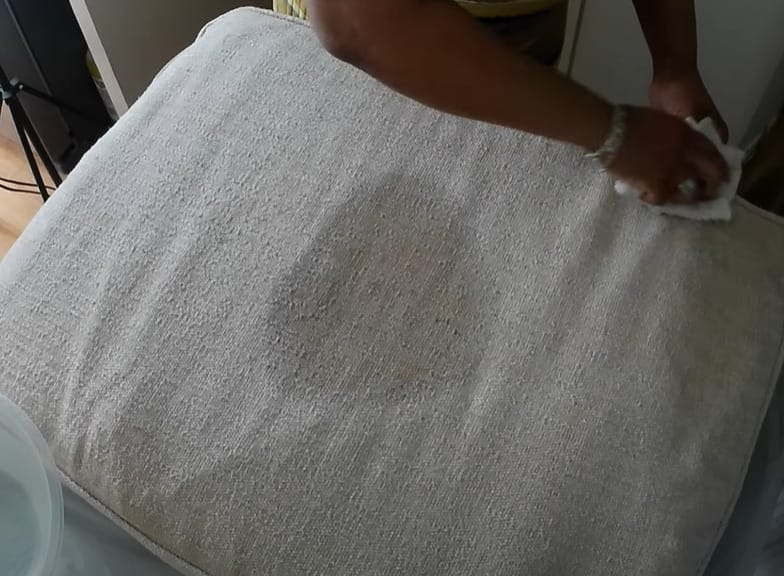
- Remember, always work from outside inwards to prevent spreading the stain.
Step 2: Using Mild Detergents
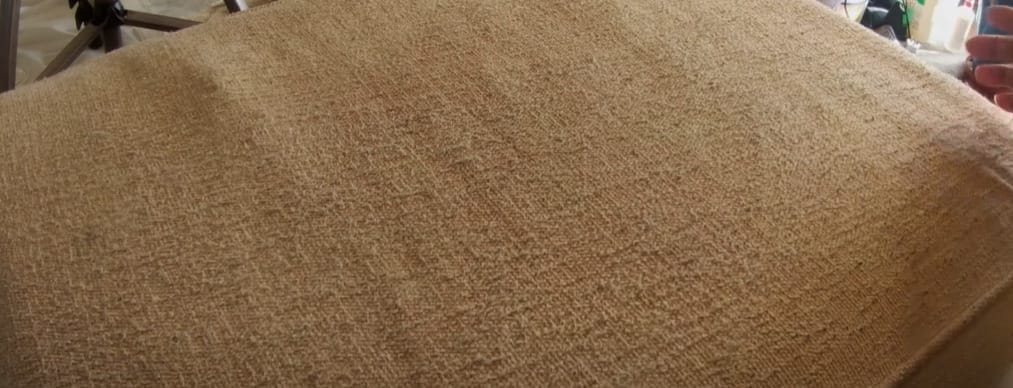
- Once you’ve blotted out as much liquid as possible, it’s time for a little soapy action!
- A few drops of mild detergent mixed with warm water can do wonders. Gently dab this mixture onto your stain until it starts to lift off.
Ink Stains
Ink stains can be stubborn, but they’re not unbeatable!
Step 1: Alcohol-Based Solutions
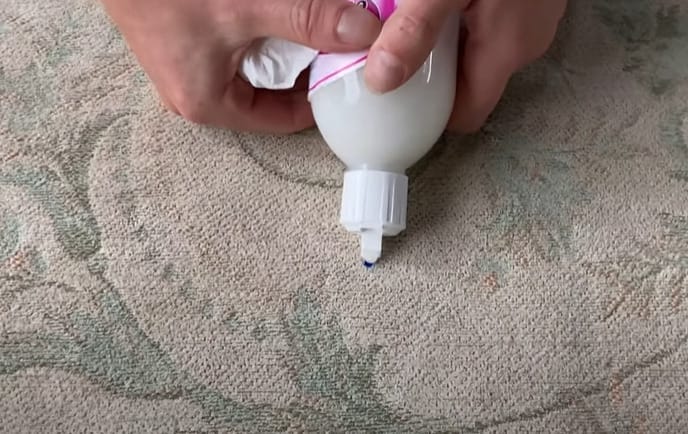
- Your first line of defense against ink spills is rubbing alcohol or hand sanitizer (Yes, that bottle in your purse!).
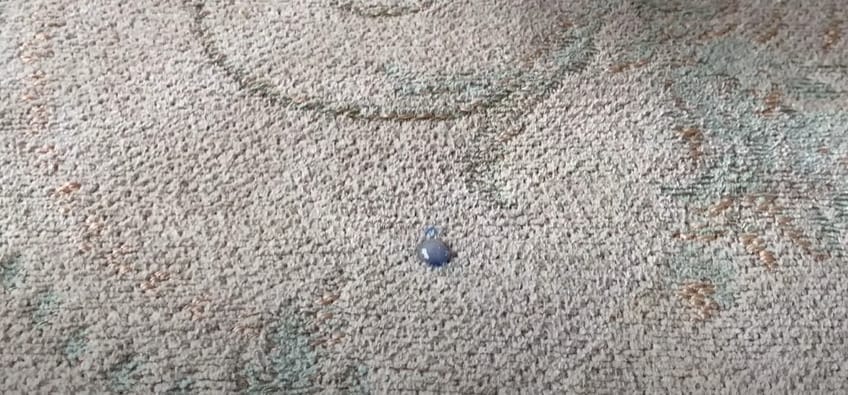
- Apply a small amount directly onto the stain, let it sit for 10 minutes, then blot gently.
Step 2: Blotting with Care

- One word: patience! It might take several rounds of application blotting before you start seeing results.
Grease and Oil Stains
Dealing with grease or oil? Let me share my secret weapon: baking soda!
Step 1: Absorbing Excess Oil
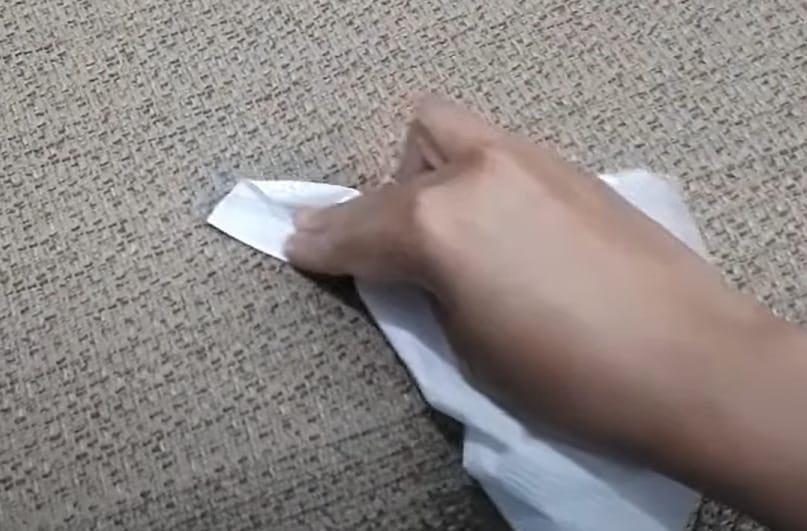
- Absorb any excess oil using paper towels.

- Then, sprinkle a generous amount of baking soda over the greasy spot. This stuff works like magic, absorbing all that excess oil!
Step 2: Detergent-Based Cleaning
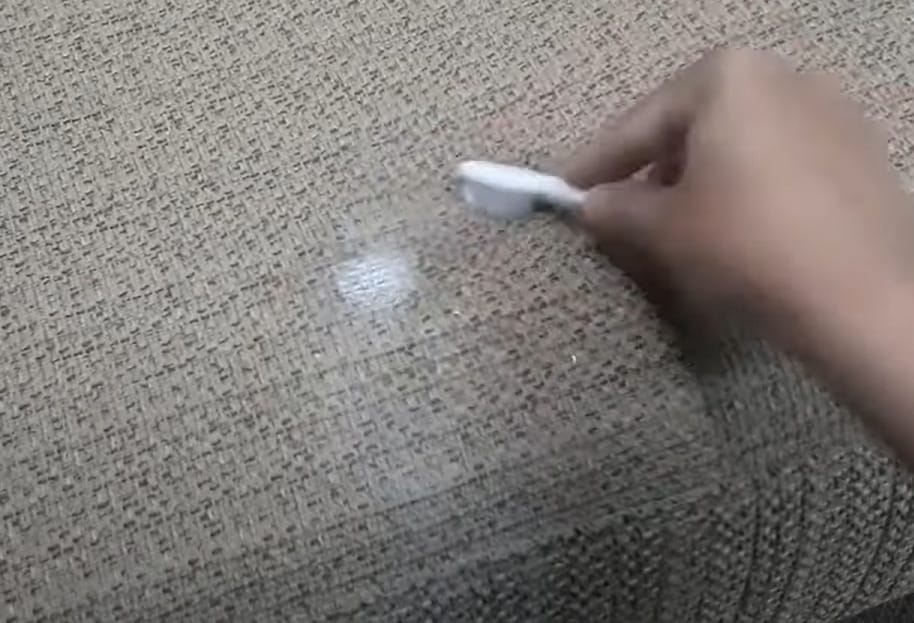
- After letting baking soda do its thing, vacuum it off.
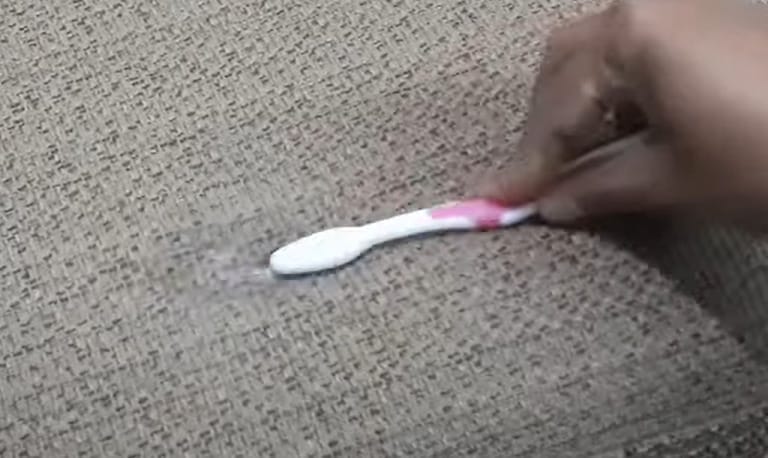
- Clean the area with a mild detergent solution.
Red Wine Stains
Celebrations can sometimes lead to a splash or two on the furniture.
Method 1: Dish liquid and Hydrogen Peroxide
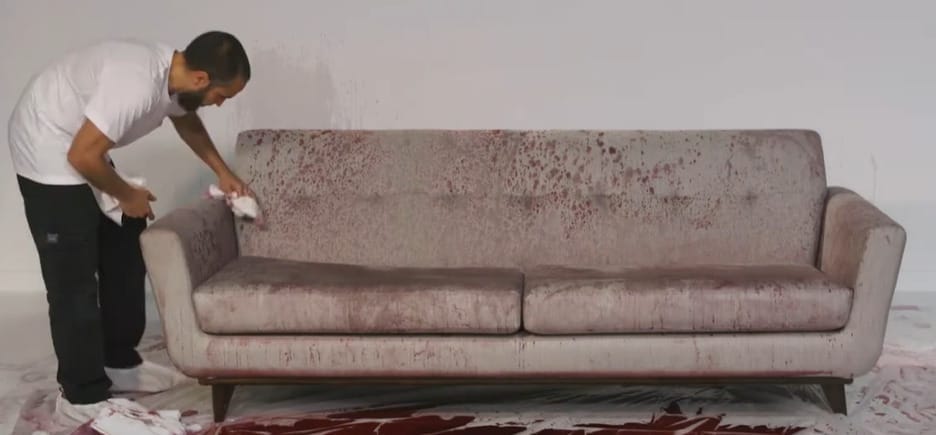
- Step 1: Immediately dab the stain as much liquid as possible.

- Step 2: Spray it with a mixture of dish liquid and hydrogen peroxide solution and let it sit for a few minutes.
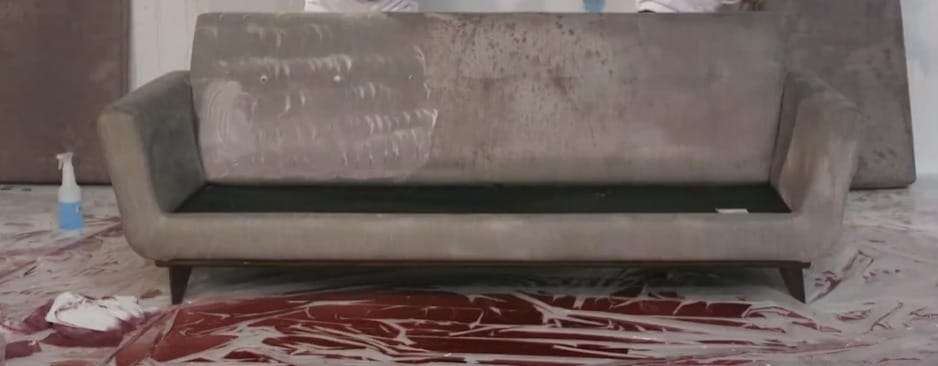
- Step 3: Scrub the area and rinse it with water. The carbonation helps lift the stain.
Method 2: Wine Stain Remover
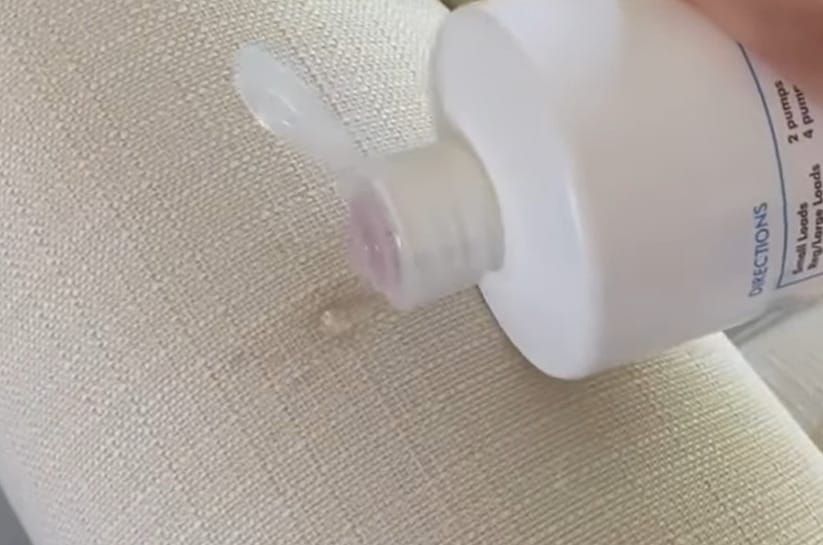
- If the stain persists, consider using a commercial wine stain remover, following the manufacturer’s instructions closely.
Chocolate Stains
Chocolate is delicious, but not so much when it’s melted into your couch.
Method 1: Detergent Solution
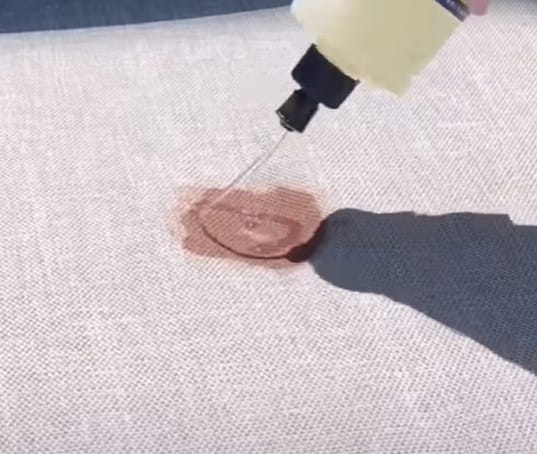
- Step 1: Mix a few drops of mild detergent with cold water.
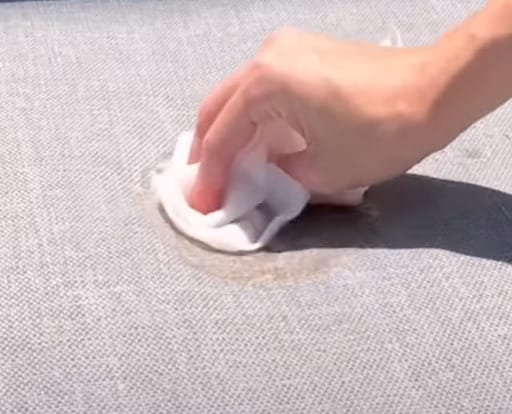
- Step 2: Apply this solution to the stain and gently blot.
Blood Stains
Accidents happen, and sometimes they leave a mark.
Method 1: Cold Water Rinse
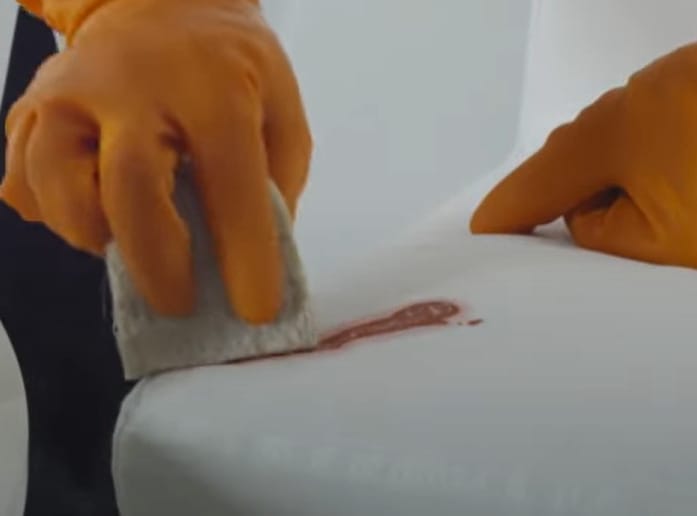
- Immediately blot with cold water. Avoid hot water, as it can set the stain.
Method 2: Hydrogen Peroxide
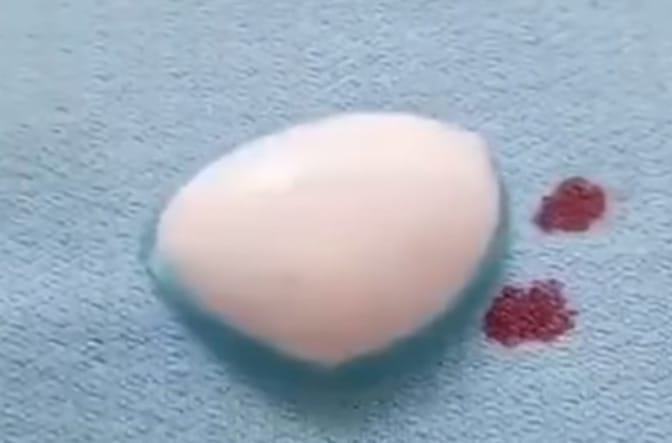
- For stubborn blood stains, consider using a 3% hydrogen peroxide solution. But be sure to test on an inconspicuous area first, as it can bleach certain fabrics.
Pet Stains
Got pets? Then there’s a chance they may pee on your furniture.
Step 1: Blotting and Removing Solid Residue
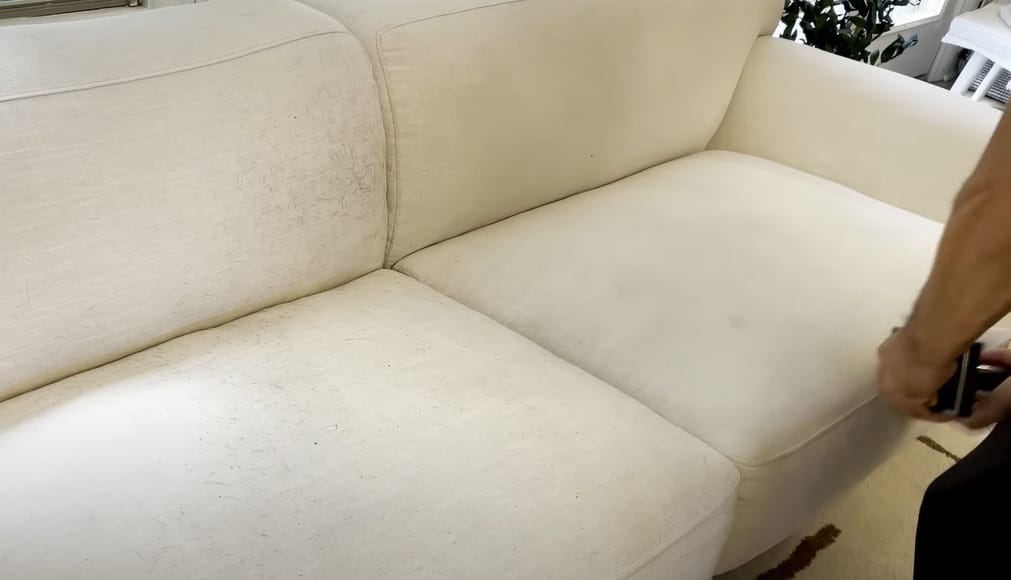
- For solid accidents, remove as much of the solids as possible before blotting up liquids.
Step 2: Enzyme-Based Cleaners

- Once you’ve done all the blotting, turn to enzyme-based cleaners designed specifically for pet messes. They’ll help neutralize odors and lift those stubborn stains off your upholstery.
There you have it! Remember, folks, when dealing with stains, act fast. The quicker you respond to a spill or stain, the better your chances of removing it completely. Happy cleaning!
Prevention and Maintenance for Upholstered Furniture

Let’s face it, life happens. Kids spill drinks, pets have accidents, and sometimes, I’ve even been known to knock over my coffee during a late-night Netflix binge. It’s part of the charm of having a lived-in home.
You can employ several strategies to prevent those inevitable spills and stains from ruining your beautiful upholstered furniture.
- Stain-resistant Sprays. These products create a protective barrier on the fabric that repels water and resists stains. They’re easy to apply – spray them onto your clean upholstery and let them dry – voila! Just remember to test any product in an inconspicuous area first.
- Slipcovers or Furniture Throws. Not only do they protect against spills and stains, but they also give you an easy way to change up the look of your room on a whim. Plus, most are machine washable, which makes cleaning up messes a breeze!
- Removable and Washable Cushion Covers. Accidents will happen (trust me, I know), but this option allows quick cleanup. Remove the cover, follow the washing instructions, and you’re good as new!
- Educate and Establish Rules. Ensure everyone knows what NOT to do (like jumping on the furniture or eating messy foods) while reinforcing what TO DO (like blotting spills promptly).
- Regular Vacuuming. For general maintenance, vacuum your upholstery every two weeks to remove dust, dirt, and potential allergens. This not only keeps the furniture looking clean but also extends its lifespan.
- Professional Cleaning. Consider having your upholstery professionally cleaned once a year or every 18 months. This deep cleaning can rejuvenate the fabric and remove any lingering dirt or oils.
- Avoid Direct Sunlight. Too much sun can fade that beautiful fabric. If your furniture is near a window, consider curtains or blinds to protect it from those harsh rays.
- Hands Off. Oils from our skin can affect upholstery over time. A no-feet-on-the-sofa rule? Not a bad idea.
Safety Precautions for Tackling Upholstery Stains
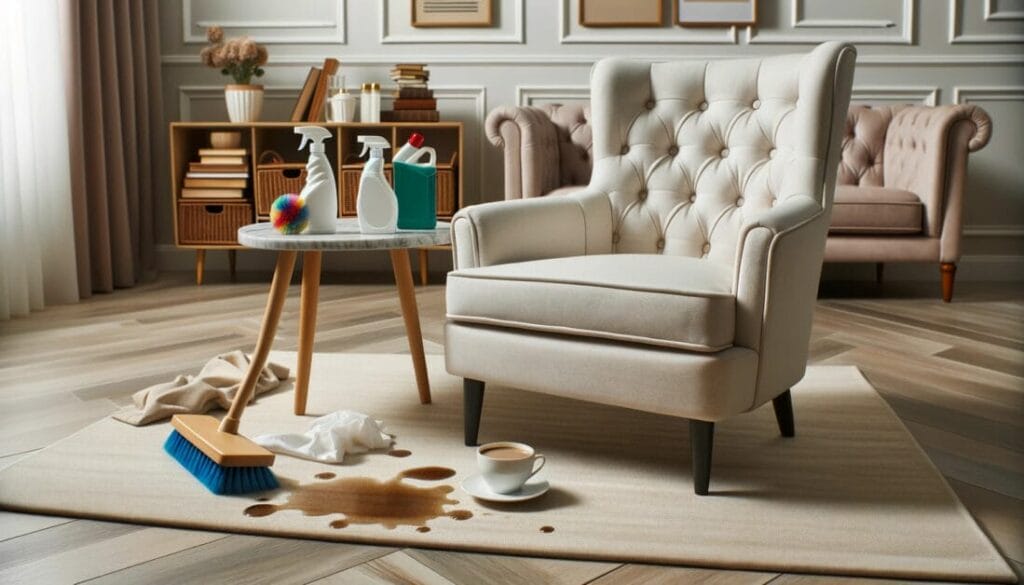
Before diving headfirst into the stain-busting world, we’ve got to chat about safety. Cleaning can be a blast, but let’s ensure we play it smart. Here’s the lowdown:
- Ventilation: Ensure the room is well-ventilated using cleaning agents, especially those with strong chemical components.
- Use Gloves: Wear gloves to protect your skin from potential irritations caused by cleaning agents.
- Storage: Store all cleaning supplies securely, out of reach of children and pets.
- Avoid Mixing Chemicals: Do not combine different cleaning agents. Some chemicals, when mixed, can produce harmful reactions.
- Rinse After Cleaning: Rinse the area with water to remove all cleaning solution residues after treating and removing a stain.
- Immediate Action: If a cleaning solution causes skin irritation, rinse the affected area with water immediately. If the irritation persists, seek medical attention.
DIY vs. Professional Cleaning
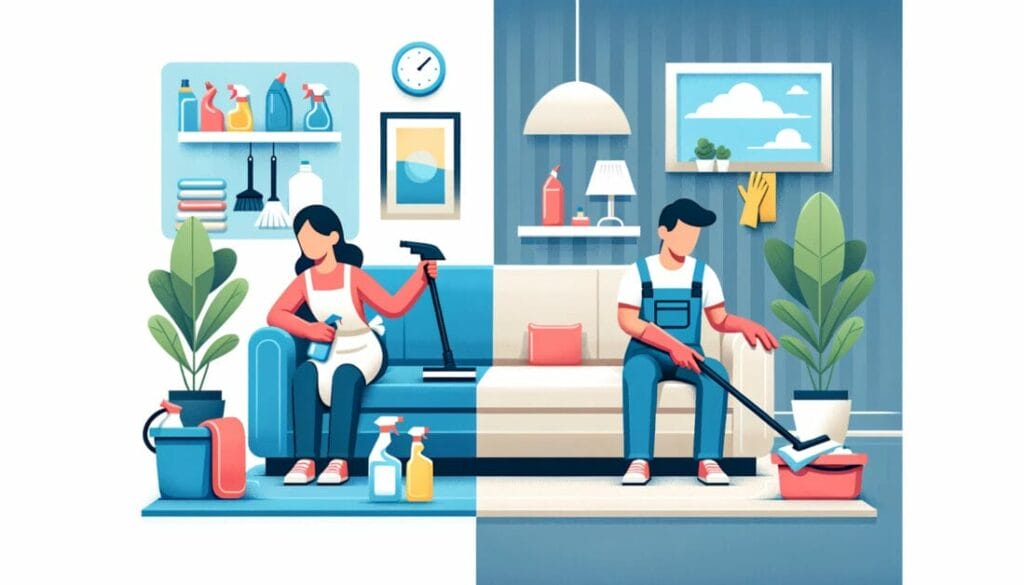
When it comes to keeping your furniture pristine, the age-old debate pops up: DIY or call in the pros? Both have merits and weighing them based on your needs is crucial.
Dive into this comparison to see which method might be your perfect fit for tackling those tricky upholstery stains and spills. Let’s break it down!
| Criteria | DIY Cleaning | Professional Cleaning |
|---|---|---|
| Knowledge | – Need to know the fabric type. – Different fabrics require varied approaches. | Professionals trained in various fabric types and stains. |
| Time | – Requires personal time and effort. | – Faster due to expertise and equipment. |
| Risk | – Potential for mistakes if unfamiliar. | – Lower risk due to expertise; typically insured. |
| Initial Cost | ||
| Cleaning Solutions | $5 to $15 (e.g., baking soda, vinegar). | Not applicable |
| Tools | $10 to $50 (e.g., scrub brush, microfiber cloths, steamer). | Included in service. |
| Service Charge | Not applicable | Typically, $100 to $200 for a sofa varies based on size and fabric. |
| Pros | ||
| Flexibility | Clean anytime you prefer. | Scheduling required. |
| Personal Touch | Customize the cleaning intensity. | Not applicable |
| Efficiency | Might take longer, especially for first-timers. | Quick due to equipment and expertise. |
| Experience | Based on personal knowledge. | Extensive experience with various stains. |
| Cons | ||
| Time | Might be time-consuming, especially if you are new to it. | Might have to fit into their schedule. |
| Effectiveness | Learning curve: stains might be challenging. | Typically, it is more effective due to specialized knowledge. |
| Potential Upcharges | Not applicable | Extra charges are possible for tough stains or added treatments. |
For minor stains or if you’re confident in your upholstery knowledge, going DIY could be a great option. But investing in professional services might be worth it for stubborn spills or expensive pieces of furniture.
Frequently Asked Questions
- How often should I clean my upholstery?
- Well, think of it this way: just as you wouldn’t wear a shirt for months without washing it, your furniture needs some regular TLC, too! For general maintenance, vacuum your upholstery every couple of weeks. For a deeper clean, especially if you have kids or pets, consider doing it every 3-6 months.
- Can I use store-bought cleaners for all types of stains?
- Not all stains are created equal, and neither are cleaners. Always test any cleaner, whether homemade or store-bought, on an inconspicuous spot first. Some fabrics can be sensitive, and the last thing you want is to trade a small stain for a big bleach spot.
- I’ve heard sunlight can help with stains. Is that true?
- Ah, the power of the sun! Sunlight can naturally bleach certain stains, especially on white or light-colored fabrics. However, be cautious, as prolonged exposure can fade the fabric. A sunbath might do the trick, but don’t leave your furniture out too long.
- How do I handle stubborn or old stains?
- Older stains can be a challenge but aren’t always impossible to tackle. First, identify the stain type and then use the appropriate cleaning method. If DIY methods don’t work, it might be time to call the pros.
- I’ve got antique furniture. Any special care tips?
- Antique furniture often requires gentler care. Avoid using modern cleaners, which might be too harsh. Instead, opt for mild soaps and always test any cleaning method on a hidden spot first.
References
Website Resources:
- Cleanipedia. https://www.cleanipedia.com/
- TheSpruce. https://www.thespruce.com/
- National Capital Poison Center. https://www.poison.org/
Video References:
TruckMountForums
EbutuoyStrohs
Spot Removal Guide
melissametrano
UltraChemLabs
Joybird
Md. Mridul Kabiraz
Cleaning How To
Safeclean-Walkingtv
Carpet One Floor & Home
CleanThatUp
domoneyfurniture1505
